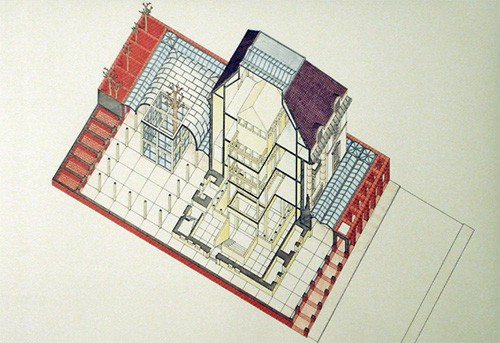O.M. Ungers
At the beginning of the 1980s, Oswald Mathias Ungers (1926-2007) received a series of large building contracts and in rapid succession he realized various public buildings of central urban significance: new monuments for the city.
After an essentially experimental work phase, which is characterized by projects that deal with the topic of form itself and by studies on the morphology of the city - studies on urban planning elements such as The Urban Villa or The Urban Block or on the southern Friedrichstadt Berlin – a new phase of the Cologne architect's morphological research begins here. The comprehensive compendium of concepts between "metaphor and metamorphosis" developed in the sixties and seventies is now confronted with the reality of the contemporary city and its imperatives. However, this is not just a moment of reviewing a conceptual design approach,
The exhibition shows drawings and models from the Ungers Archive for Architectural Science in Cologne (UAA), which document three key works from this period, which was extremely important for the work of OM Ungers: the Architekturmuseum Frankfurt, the Messe Frankfurt and the Badische Landesbibliothek Karlsruhe. These works reveal a wide range of design strategies, from restrained assimilation - as in the case of the State Library with its precise reference to the genius loci of Karlsruhe - to the complete reorganization of a large central area as in the case of the Messe Frankfurt. What all approaches have in common, however, is the ability to construct an urban place that, in a comprehensive sense, is not only a real place, but also a "spiritual, historical and social space”. These are buildings that, starting from a thematic approach, aim at the continuity of the urban form, understood as a complex whole of urban spaces and architectural bodies, giving a precise interpretation to the concrete program and the morphological context. Within this general approach to design, each project has its own solution, both in terms of building structure and spatial composition: even a relatively small project such as the Architekturmuseum shows a decidedly differentiated solution, which in this case is inspired by the concept of incorporation expires. The fragment, the objet trouvè, which appears in many of these projects, plays a special role. The fragmentary nature of the urban form is understood as a resource: according to Ungers, an urban place lives »... from the richness of discontinuity, of contradiction«. In this logic, the fragment induces the dimension of history, memory and the accidental, thus allowing a complex interpretation of the place without getting lost in the picturesque or the accidental. The variety, which already appears as a central motif of the First Houses, is recognized as an essential quality of the urban location and is deliberately worked out and exaggerated in the architectural form. of memory and the accidental, allowing for a complex interpretation of the place without getting lost in the picturesque or the accidental. The variety, which already appears as a central motif of the First Houses, is recognized as an essential quality of the urban location and is deliberately worked out and exaggerated in the architectural form. of memory and the accidental, allowing for a complex interpretation of the place without getting lost in the picturesque or the accidental. The variety, which already appears as a central motif of the First Houses, is recognized as an essential quality of the urban location and is deliberately worked out and exaggerated in the architectural form.
Following the exhibitions First Houses (2016) and Programmatic Projects (2018), the exhibition The Construction of the Urban Place is the finale in a series of three exhibitions that the Architekturmuseum Berlin is putting on in collaboration with the Archivi Storici des Politecnico di Milano and the UAA in has devoted the last few years to the architectural work of OM Ungers.
